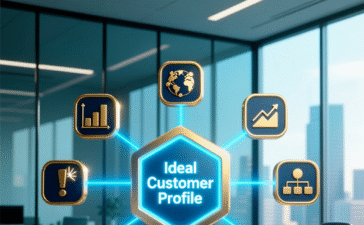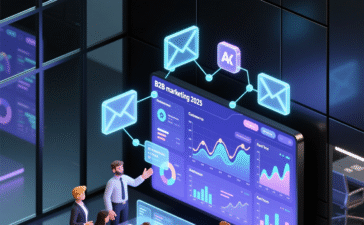The rules of demand generation are changing — fast.
In 2025, B2B marketers are under more pressure than ever to deliver measurable business impact. Buyers are more informed, attention spans are shorter, and budgets are tighter. To stay ahead, marketing teams aren’t just generating leads — they’re building revenue engines.
To uncover how top-performing organizations are adapting, we surveyed 512 B2B marketing leaders across industries and regions in early 2025. Our goal? To identify the strategies, tools, and operational shifts driving real results in today’s complex landscape.
From AI-powered personalization to revenue-aligned KPIs, here’s what the data reveals about the future of demand generation.
Key 2025 Demand Gen Trends at a Glance
Before we dive in, here are the top takeaways from the 2025 Demand Generation Benchmark Survey:
✅ 87% of high-growth companies use AI to personalize customer journeys
⚠️ 63% of marketers cite operational inefficiencies as their #1 growth blocker
📉 Only 41% can directly tie campaigns to revenue outcomes
💡 Teams with sales-marketing alignment see 2.3x higher conversion rates
🔧 76% are investing in automation and integration tools this year
Now, let’s break down what these numbers mean for your strategy.
1. Personalization Is No Longer Optional — It’s Expected
In 2025, 72% of buyers expect personalized content based on their role, industry, and behavior. Generic messaging doesn’t just fall flat — it damages trust.
Yet, only 38% of marketing teams say they’re delivering 1:1 experiences at scale.
What High-Performers Are Doing Right
The top 20% of demand gen teams aren’t just segmenting audiences — they’re orchestrating dynamic, real-time journeys using:
AI-driven content personalization (e.g., adaptive email copy, website content)
Intent data from platforms like 6sense and Bombora to trigger timely outreach
Behavioral triggers that adjust messaging based on engagement
How to Scale Personalization (Without Adding Headcount)
Start with these three steps:
Map content to buyer stages — create modular content blocks for different personas and pain points.
Use marketing automation (e.g., HubSpot, Marketo) to personalize based on firmographics and behavior.
Integrate with your CRM to ensure sales sees the full engagement history.
Pro Tip: Focus on zero- and first-party data as third-party cookies continue to phase out.
2. Operational Efficiency Is the Silent Growth Driver
You can have the best creative team in the world — but if your operations are broken, your campaigns will stall.
Our survey found that 63% of marketers struggle with inefficiencies, including:
- Manual reporting (58%)
- Disconnected tools (52%)
- Slow approval cycles (47%)
Meanwhile, high-efficiency teams report:
- 30% faster campaign launches
- 22% lower cost per lead
- Higher team morale and agility
How to Optimize Your Demand Gen Operations
✅ Integrate your martech stack — connect your CRM, marketing automation, analytics, and ABM tools.
✅ Automate reporting — use dashboards (Google Data Studio, Tableau, or native tools) to track KPIs in real time.
✅ Adopt agile workflows — run two-week sprints, hold standups, and iterate quickly based on data.
3. The Revenue Imperative: Marketing Must Prove Its Impact
In 2025, marketing is no longer a cost center — it’s a revenue driver. Yet, only 41% of teams can clearly tie their efforts to pipeline and closed deals.
This gap is disappearing among high-growth companies. In fact, 94% of fast-scaling organizations use some form of revenue attribution — whether multi-touch, revenue influence, or full-funnel modeling.
How to Align Demand Gen with Revenue
Here’s how leading teams are making the shift:
- Co-own KPIs with sales — focus on SQLs, pipeline generated, and win rates by source.
- Implement closed-loop reporting — track leads from first touch to closed-won.
- Attend revenue operations meetings — be part of the conversation, not just the campaign delivery.
The payoff?
- 36% higher win rates
- 2.3x faster sales cycles
- 42% increase in average deal size
4. AI Is Reshaping Demand Generation — Are You Ready?
AI is no longer experimental. In 2025, 81% of marketers use AI in some form — from content creation to lead scoring.
Top AI Use Cases in Demand Gen
- Predictive lead scoring 67%
- Dynamic content generation 59%
- Chatbots for lead qualification 52%
- Campaign performance optimization 48%
But here’s the catch: 61% of teams are using AI reactively — not as part of a strategic plan.
The winners are those embedding AI into their full demand gen lifecycle:
- Using predictive models to prioritize high-intent accounts
- Generating personalized subject lines and ad copy at scale
- Automating A/B testing and optimization
Action Step: Audit your current AI tools. Are you using them to save time — or to gain competitive insight?
5. What’s Next? 4 Predictions for the Rest of 2025
Based on the data, here’s what we expect to see in the second half of 2025:
1. The Rise of the Revenue Marketer
CMOs will be evaluated less on brand awareness and more on pipeline contribution, CAC, and LTV.
2. Martech Consolidation
Companies will reduce tool sprawl by adopting integrated platforms (e.g., HubSpot, Salesforce Marketing Cloud) over point solutions.
3. Privacy-First Personalization
With cookie deprecation and GDPR/CCPA compliance, zero-party data (surveys, preferences, quizzes) will become essential.
4. ABM + Demand Gen Fusion
Account-based marketing won’t live in a silo. It will merge with broader demand strategies for full-funnel alignment.
Final Thoughts: Building a Scalable, Revenue-Focused Demand Engine
The 2025 demand generation playbook is clear:
Personalize at scale using AI and behavioral data
Optimize operations to move faster and spend smarter
Tie every campaign to revenue with closed-loop reporting and shared goals
The most successful teams aren’t just running campaigns — they’re running intelligent, agile, and accountable growth engines.
Your 2025 Action Plan
✅ Audit your personalization strategy — are you going beyond basic segmentation?
✅ Streamline operations with automation and integration
✅ Align with sales on shared KPIs and revenue goals
✅ Use AI strategically — not just for efficiency, but for insight




